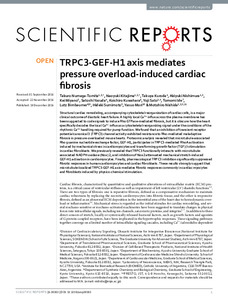Please use this identifier to cite or link to this item:
https://repositorio.uca.edu.ar/handle/123456789/8746| Título: | TRPC3-GEF-H1 axis mediates pressure overload-induced cardiac fibrosis | Autor: | Numaga-Tomita, Takuro Kitajima, Naoyuki Kuroda, Takuya Nishimura, Akiyuki Miyano, Kei Yasuda, Satoshi Kuwahara, Koichiro Sato, Yoji Ide, Tomomi Birnbaumer, Lutz Sumimoto, Hideki Mori, Yasuo Nishida, Motohiro |
Palabras clave: | FIBROSIS; CORAZON; CRECIMIENTO; CELULAS | Fecha de publicación: | 2016 | Editorial: | Nature Research | Cita: | Numaga-Tomita T, Kitajima N, Kuroda T, et al. TRPC3-GEF-H1 axis mediates pressure overload-induced cardiac fibrosis [en línea]. Scientific Reports. 2016;6:39383. doi:10.1038/srep39383 Disponible en: https://repositorio.uca.edu.ar/handle/123456789/8746 | Resumen: | Abstract: Structural cardiac remodeling, accompanying cytoskeletal reorganization of cardiac cells, is a major clinical outcome of diastolic heart failure. A highly local Ca2+ influx across the plasma membrane has been suggested to code signals to induce Rho GTPase-mediated fibrosis, but it is obscure how the heart specifically decodes the local Ca2+ influx as a cytoskeletal reorganizing signal under the conditions of the rhythmic Ca2+ handling required for pump function. We found that an inhibition of transient receptor potential canonical 3 (TRPC3) channel activity exhibited resistance to Rho-mediated maladaptive fibrosis in pressure-overloaded mouse hearts. Proteomic analysis revealed that microtubule-associated Rho guanine nucleotide exchange factor, GEF-H1, participates in TRPC3-mediated RhoA activation induced by mechanical stress in cardiomyocytes and transforming growth factor (TGF) β stimulation in cardiac fibroblasts. We previously revealed that TRPC3 functionally interacts with microtubule-associated NADPH oxidase (Nox) 2, and inhibition of Nox2 attenuated mechanical stretch-induced GEF-H1 activation in cardiomyocytes. Finally, pharmacological TRPC3 inhibition significantly suppressed fibrotic responses in human cardiomyocytes and cardiac fibroblasts. These results strongly suggest that microtubule-localized TRPC3-GEF-H1 axis mediates fibrotic responses commonly in cardiac myocytes and fibroblasts induced by physico-chemical stimulation. | URI: | https://repositorio.uca.edu.ar/handle/123456789/8746 | ISSN: | 2045-2322 | Disciplina: | MEDICINA | DOI: | 10.1038/srep39383 | Derechos: | Acceso Abierto | Fuente: | Scientific Reports. 2016;6:39383 |
| Appears in Collections: | Artículos |
Files in This Item:
| File | Description | Size | Format | |
|---|---|---|---|---|
| trpc3-gef-h1-axis.pdf | 1,93 MB | Adobe PDF |  View/Open |
Page view(s)
336
checked on Jan 7, 2026
Download(s)
340
checked on Jan 7, 2026
Google ScholarTM
Check
Altmetric
Altmetric
This item is licensed under a Creative Commons License

